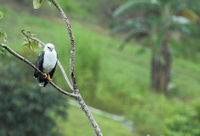White Hawk
 From Conservapedia
From Conservapedia | White Hawk | |
|---|---|

| |
| Scientific classification | |
| Kingdom Information | |
| Domain | Eukaryota |
| Kingdom | Animalia |
| Subkingdom | Bilateria |
| Branch | Deuterostomia |
| Phylum Information | |
| Phylum | Chordata |
| Sub-phylum | Vertebrata |
| Infraphylum | Gnathostomata |
| Class Information | |
| Superclass | Tetrapoda |
| Class | Aves |
| Sub-class | Neornithes |
| Infra-class | Neoaves |
| Order Information | |
| Order | Accipitriformes |
| Sub-order | Accipitres |
| Family Information | |
| Superfamily | Accipitroidea |
| Family | Accipitridae |
| Sub-family | Buteoninae |
| Genus Information | |
| Genus | Pseudastur |
| Species Information | |
| Species | P. albicollis |
| Synonyms | Leucopternis albicollis |
| Population statistics | |
| Population | Unknown (2016 est.)[1] |
| Conservation status | Least concern[2] |
The white hawk (Pseudastur albicollis) is a species of bird of prey of the family Accipitridae, and found in the tropical areas of Central and South America.
Description[edit]
The white hawk is small, about 18 to 22 inches long, a wingspan of 38.5 to 46.2 inches, and weigh from 1.43 to 1.85 pounds. Females are slightly larger than males. As the name implies, it is predominately white in color, with black upper wings; from below the wing primaries and secondaries are tipped in black, and the white tail has a single black band. Overall coloration patterns vary slightly among the subspecies. Juvenile birds bear spotted plumage above, with dark streaks on the belly.
The call has been described as a plain k'wee or p'ee'a[3].
Subspecies[edit]
- Pseudastur albicollis albicollis; Guyana, French Guiana, Suriname, Brazil (Amazonian basin), Trinidad
- Pseudastur albicollis costaricensis; Honduras to Panama and western Colombia
- Pseudastur albicollis ghiesbreghti; southern Mexico to Guatemala and Belize
- Pseudastur albicollis williaminae; northwestern Colombia to extreme northwestern Venezuela
Range and habitat[edit]
The white hawk is found in moist, forested areas and forest transitions, from southern Mexico south to Orinoco and Amazon basins of South America east of the Andes mountains.
Diet[edit]
The white hawk is primarily a still-hunter within the forest canopy, scanning the ground or branches for prey animals, such as small reptiles, birds, rodents, and insects. It has been recorded that these birds will take advantage of their prey being flushed out by the movements of other, larger animals, and it has been observed that these birds will often associate with certain species of mammals in order to obtain their prey items[4].
Threats[edit]
The species has a large range and population, but it has been noted to have decreased in number, but not enough to be considered threatened[5].
References[edit]
- ↑ https://www.iucnredlist.org/species/22695786/93527923#population
- ↑ https://www.iucnredlist.org/species/22695786/93527923
- ↑ https://www.xeno-canto.org/species/Pseudastur-albicollis
- ↑ https://onlinelibrary.wiley.com/doi/abs/10.1111/j.1744-7429.2006.00255.x
- ↑ http://datazone.birdlife.org/species/factsheet/white-hawk-pseudastur-albicollis
Categories: [Birds of Prey] [Hawks]
↧ Download as ZWI file | Last modified: 02/04/2023 03:09:25 | 4 views
☰ Source: https://www.conservapedia.com/White_hawk | License: CC BY-SA 3.0
 ZWI signed:
ZWI signed: KSF
KSF